Turning the Tide on South Africa’s HIV/AIDS Epidemic
Thirty years after it was given a name, the epidemic of AIDS and its related illnesses continues to kill millions of people around the world. But nowhere are the numbers as high today as in sub-Saharan Africa, and in particular, the nation of South Africa.
Last week, a physician who has watched her country seesaw from denial to resolve delivered the seventh annual C. Davenport Cook Grand Rounds Lecture in International Child Health at Yale School of Medicine, speaking about how things are changing in South Africa and, perhaps, all of sub-Saharan Africa. Some of the changes she described are medical, others, attitudinal.
Dr. Thembi Xulu is medical director of Right to Care, a leading non-profit HIV/AIDS organization based in Johannesburg, as well as one of this year’s Yale World Fellows. Xulu has for many years been a persistent advocate for educating South Africans about the causes of AIDS and ways to prevent it, and for bringing affordable medication to those afflicted with it. She has grappled with governments in denial, unyielding cultural traditions, lack of funding and victims too ashamed to seek help. (more…)





